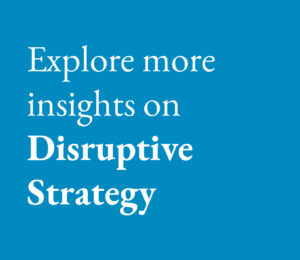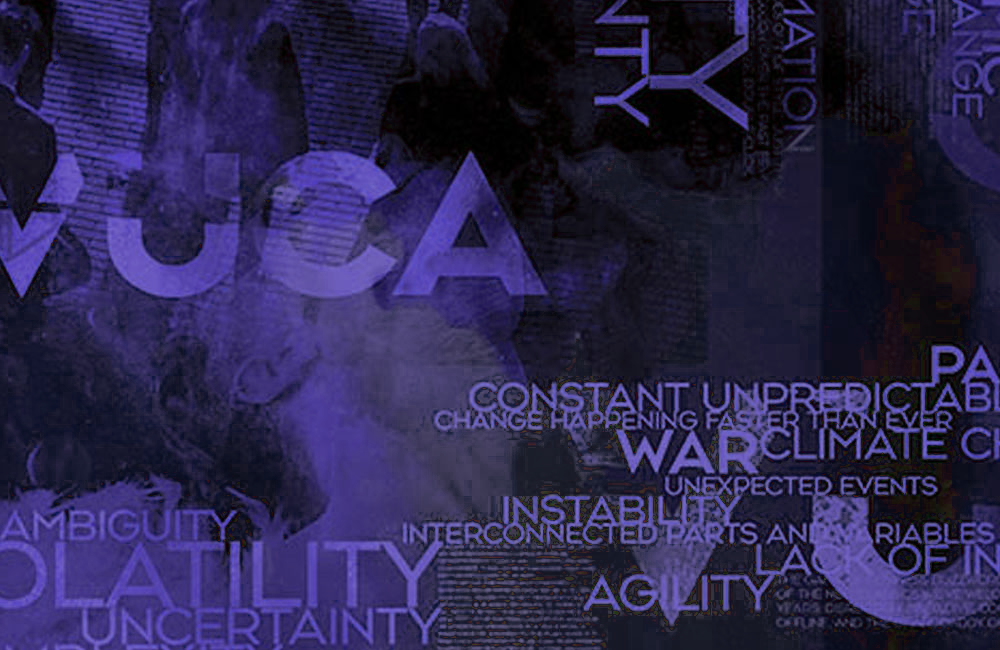Leadership in a VUCA World
Amid a pandemic, global conflicts, spiraling inflation, high energy costs and supply chain disruptions, finding a compass and navigating to success is more challenging than ever. Toss in the radical pace of change driven by digital technology and it’s clear that a company’s outlook can get cloudy very quickly. It’s against this backdrop that the notion of living in a VUCA world has become omnipresent.
We are looking at each of the four elements, exploring what they mean in today’s business environment and how companies have transformed risk into opportunity—and gains.
By keeping a laser focus on the four elements of VUCA, successful companies manage to find ways to turn them into a competitive advantage.
Volatility
Before the internet and more advanced digital technologies took hold, the barriers to entry for any given industry or line of business were extraordinarily high. It took huge amounts of capital and human brawn to get a business off the ground, manufacture products and distribute them to customers.
No longer. Amazon, Uber, Airbnb and many other companies have disrupted entire industries. They have rewired the way consumers think and act—and the ripples impact every company. The task is further complicated by a lingering pandemic and geopolitical issues, including climate change, supply chain disruptions, rampant inflation, cybercrime and conflicts around the world. Risk and insurance services provider Marsh, in its Political Risk Report 2022, pointed out that there’s no end in sight.
 Navigating rough times requires an operating model that’s agile and flexible. It may be necessary to rapidly enter new markets and exit existing ones, add and subtract products and services, adapt to new labor models such as hybrid and remote work, and rethink sourcing and outsourcing as a way to trim short-term costs. For example, during the pandemic, many tech companies witnessed manufacturing constraints due to pandemic-related lockdowns in China.
Navigating rough times requires an operating model that’s agile and flexible. It may be necessary to rapidly enter new markets and exit existing ones, add and subtract products and services, adapt to new labor models such as hybrid and remote work, and rethink sourcing and outsourcing as a way to trim short-term costs. For example, during the pandemic, many tech companies witnessed manufacturing constraints due to pandemic-related lockdowns in China.
How can business leaders manage volatility? A first step is to adopt a more modular and dynamic business framework that allows a business to change direction quickly—and scale dynamically. This requires nimbler thinking along with a digital fabric, including a cloud architecture, that supports rapid change. Yet it’s also critical to look for talent everywhere and broaden sourcing and manufacturing across multiple countries to minimize the risk of a significant disruption. Alliances, joint ventures, incubators and strategic partnerships can also play a role.
Organizations must also rethink decision-making. Within some organizations, particularly those attempting to act in a more entrepreneurial way, units and departments make decisions fast, but
they lack critical information along with a big-picture view. As a result, their decisions may benefit the group but hurt the company. Conversely, many organizations are mired in bureaucracy. Leaders ponder and debate issues endlessly, and by the time they act the problem is out of control. The sweet spot is a management team that can grab appropriate information on the fly and make critical decisions quickly, while simultaneously allowing managers to manage.

Frontier Airlines built trust in an uncertain time by offering transparent video updates throughout the pandemic.
For example, Frontier Airlines tackled pandemic-related volatility by focusing on five key issues. A management team, including Steve Schuller, vice president of human resources, adopted zero-hour schedules so employees could stay employed and keep benefits—even when they weren’t working shifts. There also was a focus on communicating honestly with employees. During the pandemic, as daily twists and turns became the norm, the management team often met online several times daily, and CEO Barry L. Biffle delivered honest and at times raw video updates. The resulting framework forged a climate of trust and has helped the airline soar through turbulent times.
Uncertainty
When business is humming along, it’s easy to fall into a complacent mindset and assume that the good times will continue to roll. Yet if the pandemic proved anything, it’s that uncertainty is a constant—and when it rears its head it often does so with a vengeance. Although contingency planning is vital for organizations, it’s critical to build a framework for solving problems rather than focusing on every possible scenario that nature or humans might toss in your direction. Events do not unfold in linear or predictable ways.
It’s critical to build a framework for solving problems rather than focusing on every possible scenario.
When uncertainty takes hold, survival-like behaviors explode. This includes a lack of focus, anxiety that leads to conflicts, paralysis from overanalysis, and turf battles that pit internal factions against one another. While it’s impossible to completely eradicate these behaviors—humans are human, after all—it is entirely possible to keep counterproductive behaviors in check and reduce the tension level with the right thinking and actions.
Successful business leaders recognize that they can’t make uncertainty go away—whether it’s a pandemic or global climate change—but they can shift resources and thinking toward new ideas, business models and products. They can also amp up communication. RHR international reports that the best efforts inform, connect, guide and unite. When uncertainty arises, these organizations communicate early and frequently, give people space to express their emotions, focus on concrete steps that align the culture, and reinforce core messaging.

Corie Barry, CEO of Best Buy, says the company is testing out a model that reduces its sales floor area and commits more space to online order fulfillment.
Reacting quickly and courageously to the pandemic paid dividends for electronics giant Best Buy, which continued to generate strong financial results through the pandemic. It immediately turned to contactless curbside pickup. CEO Corie Barry has also introduced a business model that focuses on hybrid e-commerce. The company has experimented with smaller stores with reduced sales areas while adding store space for online order fulfillment. “We’re testing our hypothesis that stores might act a little bit more as primary fulfillment hubs,” Ms. Barry has noted.
Canadian e-commerce platform Shopify is another firm that has turned uncertainty into an advantage. Early on, CEO Tobias Lütke noted that Shopify clients were increasingly taking orders from within 15 miles of their stores—a segment that generally falls below the radar for Amazon and others. Shopify responded by providing services that boosted marketing support, local pickups and various other services to help these small businesses manage expenses, pay bills and optimize local deliveries and curb pickups. The result was an uptick in sales.
Complexity
A widely accepted tenet of digital technology is that it streamlines and simplifies business operations. Although this may be true for any given project or initiative at any given moment, it’s also clear that over time layers of technology and accompanying processes contribute to breathtaking complexity. At some point, all the products and solutions that today’s technology make possible coalesce into far greater complexity.

James Quincey, CEO of Coca-Cola, says the decision to eliminate hundreds of products since 2019 is part of an effort to “ruthlessly prioritize core brands.”
This irony wasn’t lost on Coca-Cola. For decades, its product lines and profits grew while its sourcing requirements and supply chain expanded. It seemed like a successful formula for revenues—until it wasn’t. So, in 2019, the company axed 275 products and then eliminated 200 other products in December 2020. Coca-Cola CEO James Quincey described the initiative as a way to “ruthlessly prioritize core brands.”
The change allowed Coca-Cola to focus on higher-growth brands that contribute to the bulk of its revenue—and eliminate those that made up only about 2% of revenues. “We are shifting to prioritizing fewer but bigger and stronger brands across various consumer needs,” Mr. Quincey said during a conference call in December 2020. “At the same time, we need to do a better job nurturing and growing smaller, more enduring propositions and exiting some zombie brands,” he added.
Coca-Cola isn’t the only company looking to streamline business. In December 2020, consumer goods giant Mondelez eliminated 25% of its SKUs that reached across 126 manufacturing facilities and 110 distribution warehouses worldwide. In April 2020, Procter & Gamble also trimmed its product lines. Complexity can also ransack IT systems, R&D efforts, marketing and other areas.
Over time, layers of technology and accompanying processes contribute to breathtaking complexity.
Although it’s generally wise to explore opportunities and test new products, it’s critical to monitor metrics and performance closely. For example, a greater number of SKUs doesn’t necessarily translate into higher profits, even if products are somewhat successful. Simon Croom, a professor of supply chain management at the University of San Diego, has pointed out that modern supply chains often display inverse “physics.” Adding SKUs adversely affects response times, inventories and performance.
Yet there’s such a thing as positive complexity. This may include new and improved products or services that meet unmet demand, such as in an emerging food category like dairy-free or organic. These can raise brand visibility and boost margins and profits.
The takeaway? Organizations must maintain a big-picture view of complexity but also have tools such as analytics and machine learning (ML) that allow it to understand each product, service, IT system and business element in a granular way. It’s critical to identify the actual cost and value of each and every SKU—including how they change over time. Reducing complexity can free up money and staff resources. It can unshackle an organization and open a door to new innovation and even disruption.
Ambiguity
Even armed with sophisticated business intelligence (BI), analytics and machine learning tools, it’s incredibly difficult to sort through all the ambiguity in today’s business environment. It’s one thing to recognize that volatility, uncertainty, complexity and ambiguity exist, it’s another to transform data and information into insight and knowledge—and act wisely. Adding to this challenge, strategies that once seemed foolproof are no longer dependable.
History is littered with the debris of companies that couldn’t manage ambiguity and adapt to change. One of the most glaring examples is Sears, an American icon founded in 1893. The company—the equivalent of a brick-and-mortar Amazon in its heyday—once operated thousands of department stores and a phenomenally successful catalog and mail-order business. However, after an unsuccessful merger with Kmart and an inability to modernize its stores and product lines, the company landed in bankruptcy in 2018. Today, only about 200 Sears stores remain in the U.S.
History is littered with the debris of companies that couldn’t manage ambiguity and adapt to change.
Plenty of other well-known companies have also been blindsided by ambiguity. These include Radio Shack, Blockbuster, Kodak, Toys R Us, Nokia and The Limited. Confronted with critical decisions about how to navigate chaotic business conditions, CEOs and other business leaders at these firms made decisions based on past experience, without commitment to a designed future.
What makes ambiguity so difficult is that there’s seemingly no clear course—and any decision could be the wrong decision. But that’s the whole point. If an organization establishes the right framework for decision-making—while not moving too fast and hastily or too slowly and methodically—it’s possible to make small mistakes and learn from them. It’s also possible to test ideas and new products and see what works. Today’s digital technology allows this type of rapid iteration and testing. Simply hoping that an ambiguous situation will somehow become crystal clear or align with a company’s direction is a recipe for disaster.
A starting point for navigating ambiguity is to construct an internal framework to deal with the challenge. This includes a way to evaluate and analyze information as it streams in—zooming in and out as needed and looking for ways to separate knowns from unknowns. In order to gain this level of insight, there’s also a need for input across groups and disciplines. Ultimately, there’s a need to act on data while accepting that risks exist and changing direction will be necessary at times. Successful organizations recognize they will make some wrong decisions, but they also allow escape routes. This requires flexible thinking at the highest levels of the organization, and technology—such as a cloud-based infrastructure—that supports fast pivots.

Nespresso’s leadership recognized that the company needed to tread into ambiguous territory to forge a new way forward.
A good example of a company that turned ambiguity into an advantage is Nespresso. It built a brand around the concept of delivering the “ultimate coffee experience.” For decades, its high-end products were only available in selected stores, restaurants and the firm’s own coffee boutiques. But former CEO Jean-Paul Gaillard recognized that the future was murky—and it required a new course. While the desire for a high-end experience wasn’t going away, consumer preferences were changing. After carefully analyzing the market and trends, Nespresso took its capsules to hotels, restaurants and homes—and embraced a framework built on sustainability. The pivot didn’t dilute
the brand, it enhanced it.
When organizations succumb to ambiguity, it’s often because senior-level executives are clouded by past experiences and unable to see future possibilities. These past experiences may prevent them from being open to hearing new perspectives or trying new things.
Best practice organizations, on the other hand, solicit ideas from anywhere and everywhere. They anticipate issues, understand the consequences of actions, appreciate the interdependence of variables, explore alternative paths, and interpret and address relevant opportunities. This approach isn’t a guarantee for success, but it’s about the best possible inoculation against failure in a VUCA world.
This article appeared in the Summer 2022 issue of Insigniam Quarterly with the headline “The Elements of VUCA.” To begin receiving IQ, go here.






